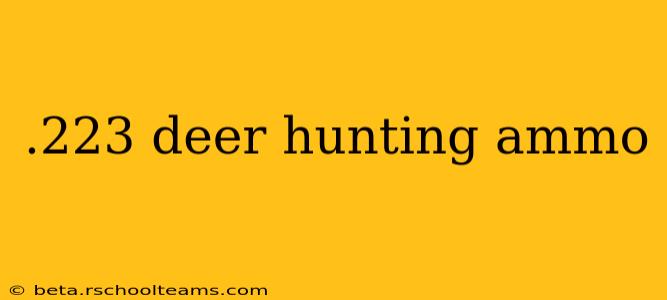Hunting deer with a .223 caliber rifle is a topic sparking considerable debate among hunters. While the cartridge's popularity stems from its versatility and affordability, its suitability for deer hunting hinges on several crucial factors, primarily shot placement and ethical hunting practices. This article delves into the complexities of using .223 ammo for deer hunting, exploring ethical considerations and offering guidance on choosing the right ammunition for a clean, humane harvest.
Ethical Considerations: Is .223 Suitable for Deer?
The primary ethical concern regarding .223 for deer hunting revolves around its relatively low energy transfer compared to larger calibers typically recommended for deer hunting, such as .30-06 or .308 Winchester. A poorly placed shot with a .223 can result in a wounded animal, leading to prolonged suffering – an unacceptable outcome for ethical hunters.
Key factors influencing ethical hunting with .223:
- Shot Placement: Accuracy is paramount. A precise shot to the vital organs (heart and lungs) is crucial for a quick, humane kill. Margin for error is significantly reduced compared to larger calibers.
- Range: Effective range is considerably shorter than with higher-powered cartridges. Taking a long shot with a .223 significantly increases the risk of a non-lethal hit and subsequent tracking challenges.
- Ammunition Selection: Choosing the right ammunition is vital. High-quality, expanding bullets designed for varmints are generally not suitable for deer. Look for bullets specifically designed for deer hunting that offer sufficient expansion and penetration at closer ranges. This typically means choosing bullets with a heavier grain weight.
- Caliber's Limitations: Understand the .223's limitations. It's not ideal for large, mature deer. If hunting in areas with larger deer, a more powerful caliber is recommended for a cleaner and more ethical kill.
Choosing the Right .223 Ammo for Deer Hunting
If you choose to hunt deer with a .223, selecting the right ammunition is critical. Consider these factors:
Bullet Weight and Construction:
Heavier bullets (around 62-77 grains) offer better penetration and energy transfer than lighter bullets typically used for varmints. Look for bullets constructed to expand reliably upon impact, creating a larger wound channel and maximizing lethality. Common bullet types include:
- Bonded bullets: These are designed to hold together better during penetration, ensuring consistent performance even on bone.
- Controlled expansion bullets: These expand reliably while maintaining some weight retention for penetration.
Avoid frangible or full metal jacket (FMJ) bullets, as they may not offer sufficient expansion for clean kills.
Other Considerations:
- Your Rifle: Understand your rifle's capabilities and limitations. Accuracy testing with different ammunition loads is essential to determine what performs best in your specific firearm.
- Shot Distance: Limit your shots to those within the effective range of your chosen ammunition and rifle. Always err on the side of caution.
- Game Size: The .223 is better suited for smaller deer, or deer at close range. Avoid using it for larger, more mature bucks.
Conclusion: Responsibility and Ethical Hunting
Using a .223 for deer hunting requires a responsible approach, prioritizing ethical hunting practices above all else. By understanding the caliber's limitations, choosing appropriate ammunition, and practicing precise shot placement at close ranges, hunters can minimize the risk of wounding and maximize the chances of a humane and successful hunt. Always prioritize ethical considerations and responsible hunting practices. If you have any doubts, it's always best to choose a more powerful caliber suitable for deer hunting.
